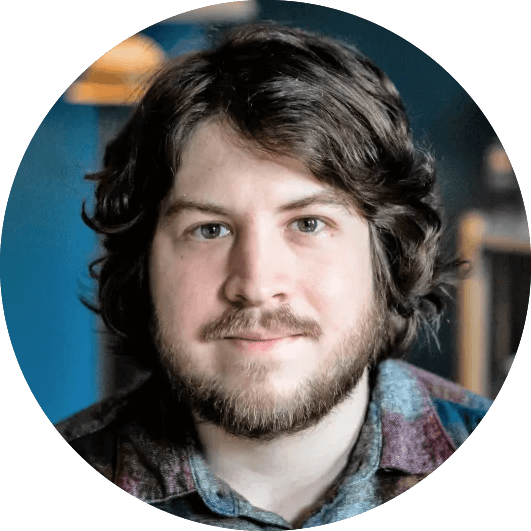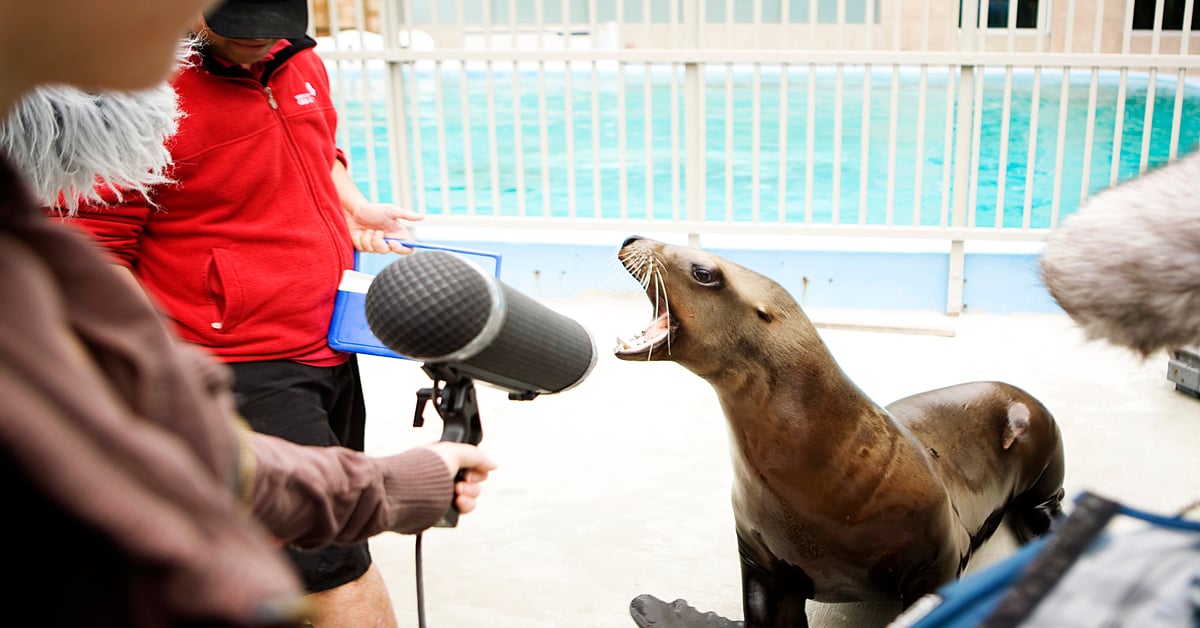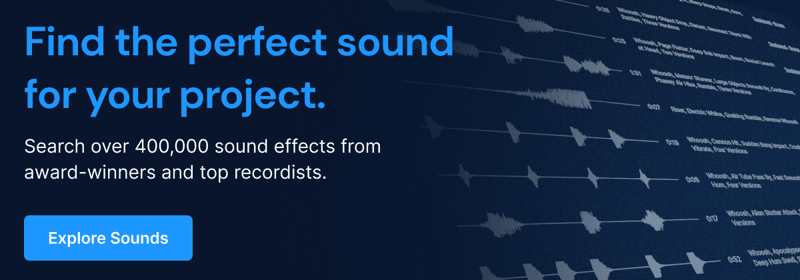Discover how various types of sound effects are created – and how they are used to tell stories in different projects.
When sound effects are done well, they combine seamlessly with dialogue, music, and moving images to immerse the audience in a story. Ideally, it should never cross the audience’s mind that these sounds were created and added separately; but if you do stop and think about it, the process of making sound effects is utterly fascinating. This article will explore some of the methods used to create different types of sound effects – but first, a little history to set the scene:
Sound effects first appeared in the context of live theater, where people offstage would use physical props to simulate real-world sounds, such as shaking a thin sheet of metal to create a rumble of thunder for Shakespeare’s The Tempest. When radio and recording technology became widespread, radio plays borrowed from the theater tradition, using techniques like banging coconut halves together in front of a microphone to create hoofbeats.
When technology finally allowed motion pictures to feature sound in the early 20th century, the art of sound effects began evolving more rapidly than ever. With the ability to create custom sounds in post-production and sync them to moving pictures, sound editors developed increasingly sophisticated methods of creating lifelike sound effects for films. Beginning in the late 1950s, the BBC Radiophonic Workshop was instrumental in advancing sound design with their experiments in synthesized sound and tape manipulation to create never-before-heard sounds that were perfect for science fiction programs of the day like Doctor Who.
Today, sound effects creators combine all of these techniques with a toolbox of ever-evolving technology to embellish movies, television, games, and technology with ultra-immersive sound. Sometimes sounds are recorded for use in a specific film project – like historical aircraft recordings for a period war movie. Other times, sound artists are simply inspired to create or capture sounds that may be useful for themselves or other creators – like retro anime sound effects or detailed camera recordings.
If you’ve ever found yourself wondering things like, “How are cartoon sound effects made?” (or if you’re interested in creating your own sound effects), follow along as we dive into the fascinating world of sound effects creation.
Types of Sound Effects
Most sound effects fall into two broad categories: "real-world" sounds and “designed” sounds. Real-world sound effects include true-to-life recordings of objects, people, animals, and environments with no significant editing or processing. Designed sounds, on the other hand, incorporate creative techniques like layering, processing, and synthesis to enhance “real” sounds for dramatic effect or create entirely new sounds. Here’s an overview of what’s included in each category:
Real-World Sounds
- Ambience refers to the soundscape of a particular place, including any natural and artificial sounds that occur there. Sound editors rely on ambience recordings to bring scenes to life with believable background sounds such as wildlife, traffic, and room tones. Ambience sound effects are typically captured using stereo, surround, or Ambisonic microphones for maximum immersion.
- Foley (named after pioneering sound artist Jack Foley) is technically the act of recording sound effects performed live in-sync to picture, using various props and surfaces. The term is often broadly used to refer to sounds made by characters and the objects they interact with. Libraries such as Foley Essentials contain ready-to-cut sounds that can save you significant time and energy. Common Foley sound effects include footsteps, clothing movement, eating, and drinking.
- Miscellaneous sounds include any other sound effect recorded as-is and not altered beyond basic cleanup and mastering. This encompasses everything from field recordings of vehicles and animals to hard-to-find items like specific vintage film camera sound effects.
Designed Sounds
- Enhanced sound effects are “larger-than-life” versions of real sounds, such as the “Hollywood-style” punches and gunshots you hear in big-budget action movies. Because normal recordings can’t fully convey the weight of a punch or the deafening blast of a gunshot, they’re often enhanced in post-production to deliver a more visceral experience. Common techniques include compression, aggressive EQ, distortion, delay, and reverb.
- Synthesized sound effects are created without the use of microphones (in most cases). Instead, sound designers use synthesizers to generate tonal or noise-based signals that are filtered and processed to create sounds not found in nature. One famous example is Star Wars’ R2-D2 – the droid’s strangely speech-like beeps and boops were created by combining a beeping and whistling analog synthesizer with a human vocal performance.
- Other imaginary sounds like fantasy creatures and magic spells don’t exist in the real world, so they have to be created from a mixture of real recordings, synthesis, and post-production enhancement.

Finnish women recording sound effects for a radio play in the 1930s.
Recording Real-World Sound Effects
Real-world sounds are either recorded in a studio or “in the field” (meaning anywhere outside of a studio). There are infinite recording setups and techniques to use, each suited to different situations. For example, a serious field recordist might carry a multichannel recorder and a surround-sound mic array for recording natural soundscapes, while a Foley studio would probably prefer a single high-quality shotgun microphone with a premium preamp and A/D converter for maximum detail and sound quality.
- Recording sound effects in the field – when it comes to capturing sounds outside of the studio, recordists choose their equipment based on what they’re recording, the environment it’s in, and how mobile they need to be. Handheld recorders are great for quickly capturing sounds on-the-go, while standalone recorders offer more flexibility, features, and battery life for serious shoots. Shotgun condenser microphones are the most common type of mic for field recording because they reject ambient noise well, but some recordists use specialized equipment like parabolic microphones, hydrophones, and contact mics.
- Recording ambiences – ambiences are usually recorded in stereo, quadraphonic, or Ambisonic formats. For stereo recording, you can use a handheld stereo recorder, a stereo mic array, or even a set of ear-mounted binaural microphones. Many ambiences are recorded in quadraphonic or other multichannel formats to provide surround sound for film use. Lastly, Ambisonic mics capture a full-sphere soundfield including height information, which can then be converted to many different formats.
- Recording Foley and props – recordists working in a studio environment aren’t limited to portable gear, which frees them up to use whichever type of microphone works best for a particular source. Shotgun mics are still the most popular option for capturing detailed Foley, although other large- and small-diaphragm condenser mics are used as well. Foley studios are specialized workspaces, often containing an array of clothing, footwear, surfaces to walk on, and extensive acoustical treatment to reduce unwanted reverberation.
Designing and Synthesizing Sound Effects
Whether creating laser gun sounds for sci-fi games or eerie, unnatural ambiences for horror movies, sound designers excel at coming up with unorthodox ways to make sound effects. Between analog and software synthesizers, plugins for creative processing, and techniques like pitch manipulation and time-stretching, the sound design possibilities are truly limitless.
- Designing futuristic sounds – When you need to design the sounds of the future, synthesizers are a great place to start. Within minutes of tweaking an oscillator and a filter, you can create a huge variety of “beeps” and “boops,” and by adding more oscillators and modulation you can quickly produce complex, evolving sounds. You can even run existing sound effects through a synthesizer to give them an artificial flavor that’s great for robot voices and high-tech communication systems.
- Designing magical sounds – Magic spells and enchanted relics are great opportunities to get creative with sound design. One technique is to start with a natural sound such as a smoldering fire, shape the pitch and volume envelopes to create movement, then add processing such as delay and reverb to give it that “magical” vibe. Before you know it, you’ve got an awesome fireball spell.
- Designing creature sounds – What do aliens, mythical beasts, and horror-movie monsters have in common? You guessed it: sound design! From mighty dragons to ethereal spirits, sound designers have long used creative techniques to make imaginary creatures come to life. Some examples include layering multiple animal vocalizations to create a beastly roar, pitch-shifting footsteps to make them sound bigger, and processing speech to create demonic voices.
Sweetening, Mastering, and Metadata
Once sound effects are recorded or otherwise created, getting them ready for use involves a few final steps. First, noise reduction software may be used to eliminate unwanted hiss or hum. Sometimes unnecessary low or high frequencies are filtered out. EQ may also be used to "sweeten” the sound by bringing out the tonal character, and compressors and limiters may be used to help smooth out volume dynamics and prevent distortion from clipping.
Pro Sound Effects takes a more naturalistic approach to editing recordings – opting to process the sounds as little as possible so that sound artists using the files can choose to do that on their own. Instead, the primary goal is to preserve as much of the original recordings as possible, cleaning only when necessary.
After cleanup and sweetening, each individual sound (or set of sounds) must be rendered as its own file. At this stage, files are trimmed to start right at the beginning of the sound and end just as it dies out, with no empty space. Levels are also tweaked at this stage to make sure each sound is loud enough to be heard clearly, but still retain the full dynamic range of the sound.
The final step is to embed metadata in the files such as category and descriptive keywords, or info like number of channels, the recordist’s name, the date of recording, and so on. Pro Sound Effects uses the Universal Category System (UCS) metadata standard for all sound effects files. Having this data attached to the file itself helps ensure that each sound is easily searchable using library management software like SoundQ and that it contains any information a user might need to know, such as languages being spoken in the background of an urban field recording.
Conclusion
There you have it: an introduction to how movie sound effects are made, as well as a few strategies you can try when recording or designing your own sounds. To learn more, check out our blog for interviews with award-winning sound artists like Richard King, helpful sound design tutorials, fascinating mini-docs on film sound pioneers, and more.
Featured image credit:
Photo by Vancouver Film School
Creative Commons Attribution 2.0 license
Dante Fumo is a Midwest-based sound designer, editor, and mixer specializing in independent film and Dolby Atmos mixing. In his free time, Dante composes electronic music and publishes Harmonic Content, a zine about sound.














